Spring ephemerals are the hit of the season right now. For the past few weeks they have taken turns blooming in the eastern forests of North America.
One such Spring Ephemeral is Jack-in-the-Pulpit, Arisema bulbosa. A unique and irregular flower, Jack-in-the-Pulpit can be found in moist and wetland areas, such as lowlands, river bottoms, creeks and drainage areas.
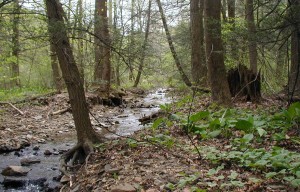
Creek side habitat where Jack-in-the-Pulpit can be found. Cohorts included Miterwort, Wild Ginger and Spring Beauty.
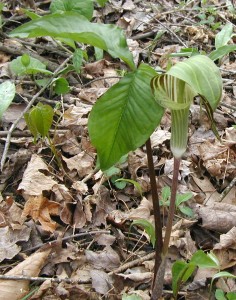
The flower is actually a colonial one with an odd construction. the flowers are covered from view inside the spathe, which is the outer cup-shape that has a striped hood. Many small yellow flowers cover the bat-shaped spadix that sits in the spathe. The spathe protects the group of flowers on the spadix.
The spathe is streaked with brown to maroon lines, the top of which forms a hood over the club-like spadix. In the image above you can see two of three leaflets of the compound basal leaf.
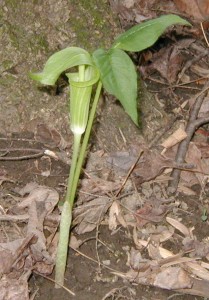
The spathe in the image above is marked with light green lines. The plants without brown or maroon markings appear to be smaller, perhaps younger ones.
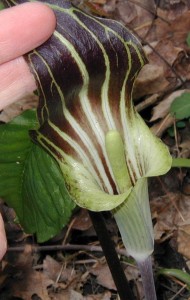
A closer look at Jack, the club-like spadix.
Jack-in-the-Pulpit is so named because the spadix (Jack) appears to stand inside the spathe (pulpit) in just a way that preacher might stand in a pulpit.
Jack-in-the-Pulpit emerges from the ground with fully formed leaves. The leaves emerge rolled up and folded. A single, basal compound leaf is usually present that gets to be about a foot tall. Three leaflets are oval in shape and come to a point. One leaflet points up and the other two point down so the leaf appears to be triangular. Small basal leaves, a few inches tall, may also be present. The flower stem arises separately from the leaf stalk.
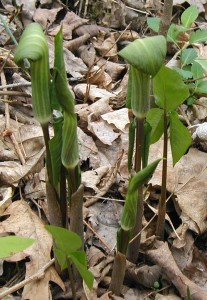
Note the wrapped up look to the leaves of Jack-in-the-Pulpit.
When you see new plants from different angles it helps to illustrate the true structure and dimensions of what you’re inspecting.
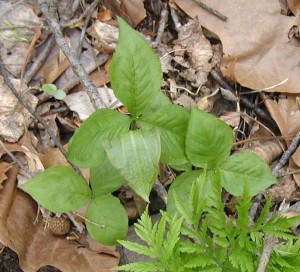
Looking down on a Jack-in-the-Pulpit plant you can see three basal leaves in threes and one spathe in the center of the three compound leaves. Other plants growing in the same habitat include ferns and other allies that need moist conditions.
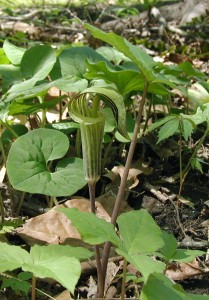
In this sideview of Jack-in-the-Pulpit, photo taken 30Apr2010, you can see that Jack’s head doesn’t touch the hood of the spathe. Note that the round or heart-shaped leaf on the left is wild ginger.
These photographs of Jack-in-the-Pulpit were taken at Little Buffalo State Park, Newport, Pennsylvania. All other photos taken 18Apr2010.
1 thought on “Jack-in-the-Pulpit A Wetland Spring Ephemeral”